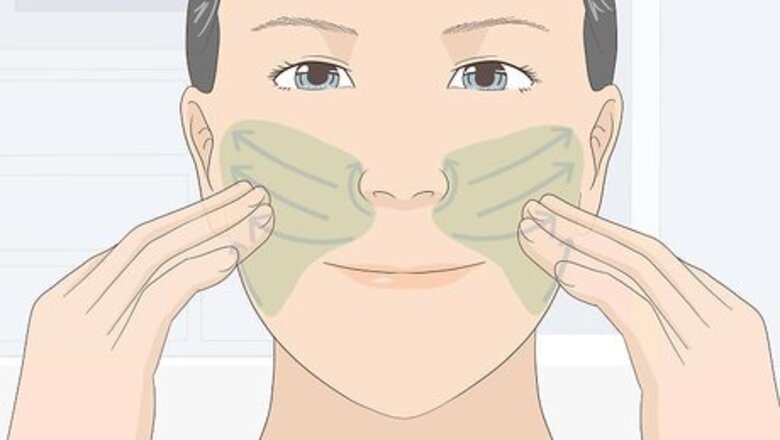
views
Improving Circulation
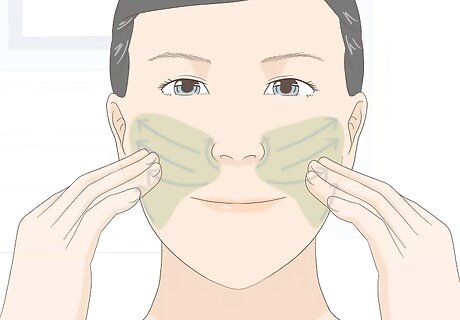
Massage your cheeks to lift and brighten your skin. When giving yourself a facial massage, work your fingertips in soft, circular motions around your cheek area. Make sure you move your skin up and outward; avoid pushing it down as this may encourage sagging. Focus on your cheekbones, cheek cavities, and the area near your nostrils, as well as the bottom of your cheeks near your jawline. You may not actually get physically chubbier cheeks this way, but a gentle massage like this will help improve your circulation and will bring some rosy color to your face.
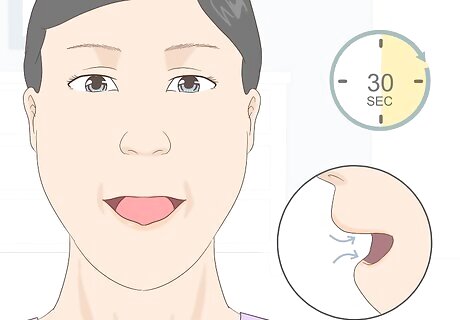
Practice face yoga to improve the circulation in your cheeks. Open your mouth wide and curl your upper and lower lips inward so that they cover your front teeth. Keep them taut over your teeth draw the corners of your mouth outward. Gently shift your jaw forward, too. Stay in this position for about 30 seconds. You’ll feel tightness around your cheek muscles and mouth area. Release to a normal resting face when you’re done. Repeat this exercise 5 times per day. When practicing face yoga, sit upright, open up your chest, and lower your shoulders to release the tension in your body. Similar exercises include puffing up your cheeks into a fish-face and pretending you’re blowing balloons. If you follow this technique, no extra fat or skin will actually develop in your cheeks. However, the gentle facial exercise will stimulate circulation in your cheeks which might make your skin look more radiant and full.
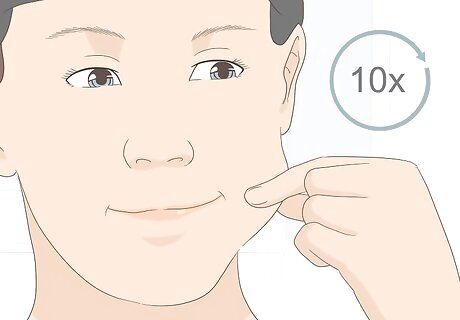
Pinch your cheeks to give them a naturally rosy color. Use your thumb and index finger to gently squeeze the fleshy portion of your cheeks. Work gently but quickly, pinching each cheek about 10 times. While pinching your cheeks won’t actually make them plumper, this practice will draw more blood into your cheeks to give your skin a natural blush. Brighter, rosier cheeks look more youthful and healthy compared to colorless ones. The rosiness might only last a few minutes, but it’s a great trick to use before taking a photo or when making a first impression.
Applying Topical Treatments
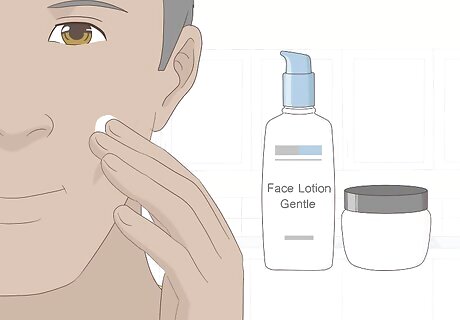
Keep your face moisturized to soften and hydrate your cheeks. Use a gentle facial lotion or moisturizing cream on your cheeks on a daily basis. Apply it to damp skin, directly after every shower and every time you wash your face. Let it soak into your skin; don’t rinse it off. Choose a moisturizer with SPF properties to protect your cheeks from sun damage. Try an emollient cream containing glycerin or petroleum jelly. These creams are specially formulated to soothe dry and damaged skin. While moisturizers won’t add volume to your cheeks, they will make dry skin soft and dewy, giving you an overall healthier, more youthful appearance.
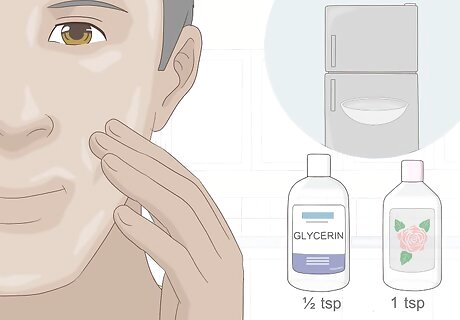
Apply glycerin and rosewater to repair the collagen in your cheeks. Combine ⁄2 tsp (2.5 mL) of rosewater with 1 tsp (4.9 mL) of undiluted glycerin. Store the solution in the refrigerator, and massage it into clean skin every night just before bed. Leave it on overnight and rinse your face off in the morning. After about a week, you’ll start to notice softer, plumper skin around your cheek area. Glycerin keeps the skin hydrated and helps repair damaged collagen, while rosewater can help hydrate and calm irritated or dry skin.

Use aloe vera gel to improve your skin’s elasticity. About 30 minutes before you take a shower, massage aloe vera gel directly onto your cheeks and allow it to soak in. Or apply the gel to your face and rinse it off about 30 minutes later with warm water. Repeat this process daily to soften and plump up your cheeks. Alternatively, you could drink an 8 oz (250 ml) glass of food-grade aloe vera juice each morning. Try this for about a month and see if you notice any change in your complexion. The Vitamin E and antioxidants in aloe vera help reduce inflammation and may help tighten up sagging skin.

Massage milk and honey into your cheeks to keep the skin soft and smooth. Look for an organic face mask with milk or honey listed as ingredients. Or combine 1 tsp (4.9 mL) of milk with 1 tsp (4.9 mL) of honey to make a homemade treatment. Rub this paste onto your cheeks and allow it to sit there for about 20 minutes before you rinse it off. Try this once a day for a week. Try cream or yogurt instead for even softer skin. When used topically, honey acts as a humectant, attracting and trapping moisture in the skin. Milk provides nourishing proteins and helps boost skin cell and collagen repair. As a result, your skin may look healthier and plumper after a milk and honey face mask. Try drinking a glass of milk every day, too, so your body benefits from its nutrients.
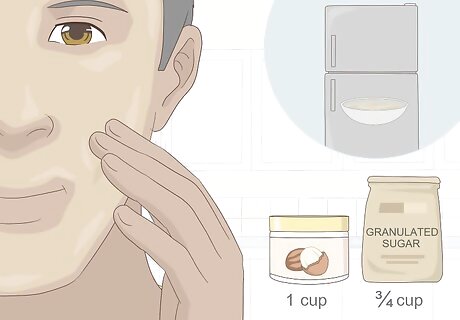
Use a shea butter and sugar scrub to exfoliate your cheeks. Mix together 1 cup (240 mL) of melted shea butter with ⁄4 cup (180 mL) of granulated sugar. Refrigerate this mixture until it solidifies, then apply the scrub to damp skin using gentle circular motions. Leave it on for 5 minutes before rinsing it off with warm water. Use a soft towel to pat your skin dry when you’re finished. The sugar is a gentle exfoliant, so it can scrub away dead skin cells on your cheeks that would otherwise make the skin look dull. Shea butter is high in fatty acids and vitamins, so it can help soften your skin. You can just apply plain shea butter if you want to nourish your cheeks without exfoliating. As an alternative, substitute the shea butter for milk, yogurt, or cream for another nourishing sugar scrub.

Make an apple paste to plump up your cheeks. Apples contain many nutrients and vitamins that benefit your skin, so applying them topically can work wonders. Chop up 1 whole apple into chunks and use a potato masher or a handheld blender to mash it into a sauce-like consistency. Apply this paste directly to your cheeks, and leave it on for about 20 minutes before rinsing off with warm water. Apples are full of antioxidants as well as vitamins A, B, and C, which can help prevent tissue damage and wrinkles. They also contain collagen and elastin, which keep your skin looking soft and plump. You can also drink fresh apple juice and snack on apples on a daily basis to add the fruit’s benefits in your diet.

Rub natural oils into your cheeks to give your cheeks a healthy glow. After washing your face, massage a few drops of oil onto your cheeks and leave the oil on overnight. Try coconut oil, olive oil, almond oil, fenugreek oil, or avocado oil. Although your skin naturally produces its own oils, applying natural oils topically can keep your skin looking dewy and perky. Work healthy fats and oils into your diet, too. Cook with olive oil, eat plenty of fish, and eat nuts as a snack.
Using Makeup
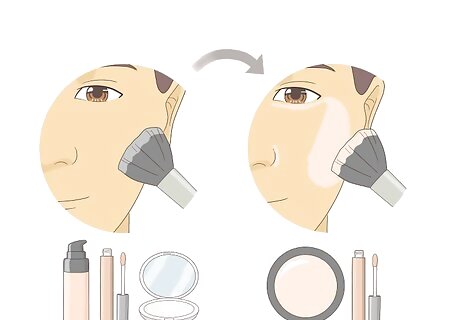
Create the illusion of fuller cheeks with a lighter powder or concealer. Apply your foundation, concealer, and setting powder as usual. Then use a powder brush to dust on a layer of matte powder in 1 shade lighter than your natural skin tone. Apply this around your cheek area, concentrating on the cheekbones and any sunken-in areas. Or apply a liquid or cream concealer that’s 1 shade lighter than your natural skin tone around your cheeks to make them pop. Apply the lighter concealer to any areas around your face featuring dark shadows that draw your cheeks downward. Try eliminating dark undereye circles or dark lines around your mouth with a color-correcting concealer to make sure the upper parts of your cheeks really stand out.
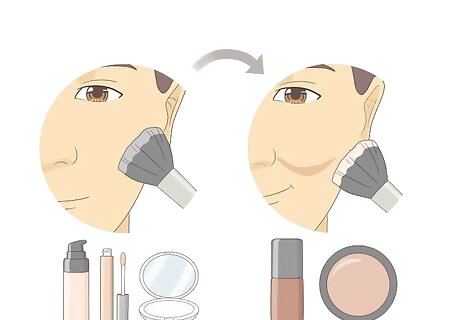
Use blush to contour the apples of your cheeks so they look rosy and full. Try out a shimmery powder or a cream blush formula until you find which product you like best. Once you’ve applied your base of foundation, concealer, and powder, smile in the mirror so you can find the fullest part of your cheeks, known as the apples. Then use either a blush brush or your fingertips to apply the product around this area. Instead of sweeping on the blush in an angular motion, place it strategically around the bottom and outside edges to subtly contour the apples of your cheeks. Pinch your cheeks to see what color your cheeks turn when they’re naturally flushed, then choose a blush in a similar hue. Avoid extending the blush below the apples of your cheeks or your cheekbones; this will only make your face look more sunken in.
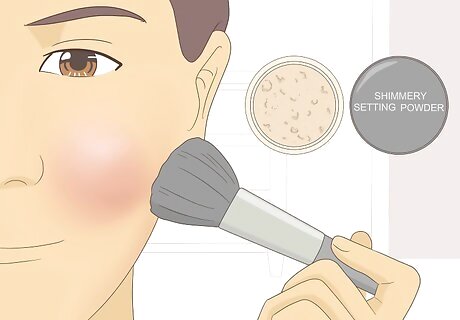
Finish off your plump cheeks with a shimmery setting powder. Pick a setting powder with subtle levels of shimmer to give your face a youthful, natural-looking glow. Use a powder brush to apply the product around the top of the apples of your cheeks and the top of your cheekbones. Extend it beneath your eye area, too, to brighten and lift the whole area. The shimmer will catch the light and deceive the onlooking eye into seeing plumper, more youthful cheeks. Avoid anything too sparkly or glittery; it will appear more artificial and might draw attention to your sunken cheeks.
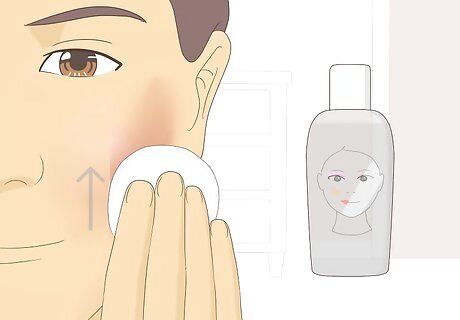
Remove your makeup at the end of every day to keep your skin clear. Never sleep in your makeup; you’ll only speed up the aging process and contribute to uneven complexion. Instead, use a gentle cleansing cloth or liquid makeup remover to take off any cosmetics you’ve worn during the day. Use the cloth or a cotton pad to gently massage your face and lift off the makeup. Work in an upward and outward motion so as to not drag your skin down. Follow up by rinsing off your face with warm water, then apply a hydrating moisturizer to keep your skin plump. Every once in a while, don’t wear makeup for a day or 2 to give your skin a chance to breathe.
Fattening Your Cheeks

Gain weight safely to achieve a chubbier appearance. If you’re underweight, gaining weight will add to your body mass and might plump up your cheeks. Keep a food journal to help you keep track of what you’re consuming. Eat about 200 more calories than you’d typically need, to start with, to kickstart your weight gain. Focus on eating nutrient-rich, calorie-dense meals and snacks throughout the day, and try drinking healthy smoothies to get more calories. Focus on strength training rather than cardio training while you attempt to gain weight. Consider working with a nutritionist during this process, and be sure to talk to your doctor before making lifestyle changes. Keep in mind that the fat may not appear immediately around your face. Depending on your body type, you may notice weight gain in other parts of your body first.

Consider fat transfer surgery or facial implants for a surgical change. Schedule a consultation appointment with a cosmetic surgeon to discuss whether either of these procedures would be right for you. Depending on your facial structure and how much fat you have elsewhere in your body, a cosmetic surgeon may be able to move fatty tissue to your cheeks. Or you can ask them about inserting implants to give you chubbier cheeks. Communicate your specific ideas about your desired cheek contours to the surgeon with reference images so you can discuss all of your options in detail. Keep in mind that the average cost of facial implants is around $3,000 US.
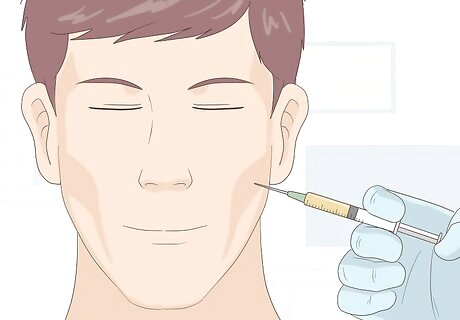
Get dermal injections to plump up your cheeks in a less-invasive way. If you want to add the volume back to your face to counteract signs of aging, speak with a cosmetic surgeon about dermal injections or fillers. Small quantities of real or synthetic fat can be gradually injected into your cheeks using a fine needle. Prepare to go back for several procedures in the beginning and over the years if you want to keep your cheeks round and plump. Dermal injections can last from 6 months to a few years.




















Comments
0 comment